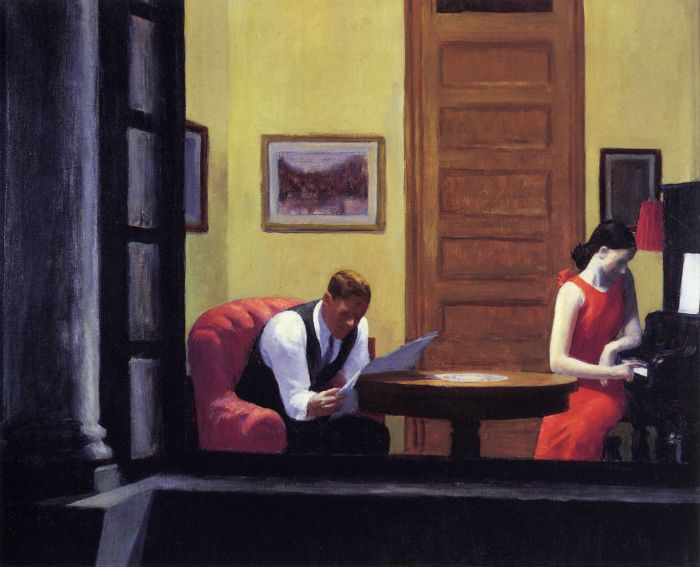
Room in New York
Edward Hopper, 1932

Room in New York
Edward Hopper, 1932
Hopper excelled in painting, discreetly and from without, people who are outsiders to one another. You imagine him staring from the Second Avenue El as it rattled past the lit brownstone windows, storing the enigmatic snapshots of home and business for later use. These are reconstructed scenes, emotion recollected in tranquility. In Room in New York, 1932, it is night; a man reads a paper at a round table, a woman turns away in her own absorption and boredom, touching the piano keyboard with one finger. They are out of synch, and their distance from each other is figured in the simple act of a woman with a shadowed face sounding a note (or perhaps only thinking about sounding it) to which there will be no response. No doubt Hopper saw something like this, yet not very like it. The space would not have been measured by his three exact and conscious patches of red: the armchair, the woman’s dress, the lampshade. The figures would have been remote. In the picture they are large, and we are close to them, outside their window. You don’t for a moment imagine Hopper on a scaffold outside the window or spying on the couple through a long lens. And yet the painting does evoke the pleasure, common to bird and people watchers, of seeing while being unnoticed; it does put your eye close to the window, several floors up; and this contributes a dreamlike tone to the image, as though you were levitating while the man and woman remained bound by gravity. This is not realism, but the scene is intensely real, a vignette framed in the dark proscenium of the window.
—from a review of Edward Hopper’s work by Robert Hughes, Time Magazine, 7/17/95
Throughout his life Hoppper stated that his art was not an exact transcription of nature; it was a condensation of many scenes and impressions. “I’m always at a loss when asked for facts about any of my pictures or to describe how any one of them came to be made,” he told Lloyd Goodrich. “It is so often a very complicated mental process that would not interest people.” Hopper’s art depended on memory as well as inspiration. He searched for a typical scene, not a unique one, and found he frequently had to cull from a number of experiences and reduce them to a common denominator to make his art. The real world was often too unique, and a specific locale frequently did not render the commonality of the true “American scene,” a term he later learned to hate because it became associated in many people’s minds with a nostalgic and Romantic view of the world. His description to Lloyd Goodrich of the origins of Room in New York (1932) underscores his method of creation:
The idea for Room in New York had been in my mind a long time before I painted it. It was suggested by glimpses of lighted interiors seen as I walked along the city streets at night, probably near the district where I live (Washington Square), although it’s no particular street or house, but it is rather a synthesis of many impressions.
The viewer implied in this painting is a city dweller who, like a voyeur, knows intimate aspects of strangers’ lives. Hopper has chosen to blur the facial features of the couple here and shows them as types, thus indicating that our view of their world does not allow us to understand them as individuals.
—from Edward Hopper, by Robert Hobbs